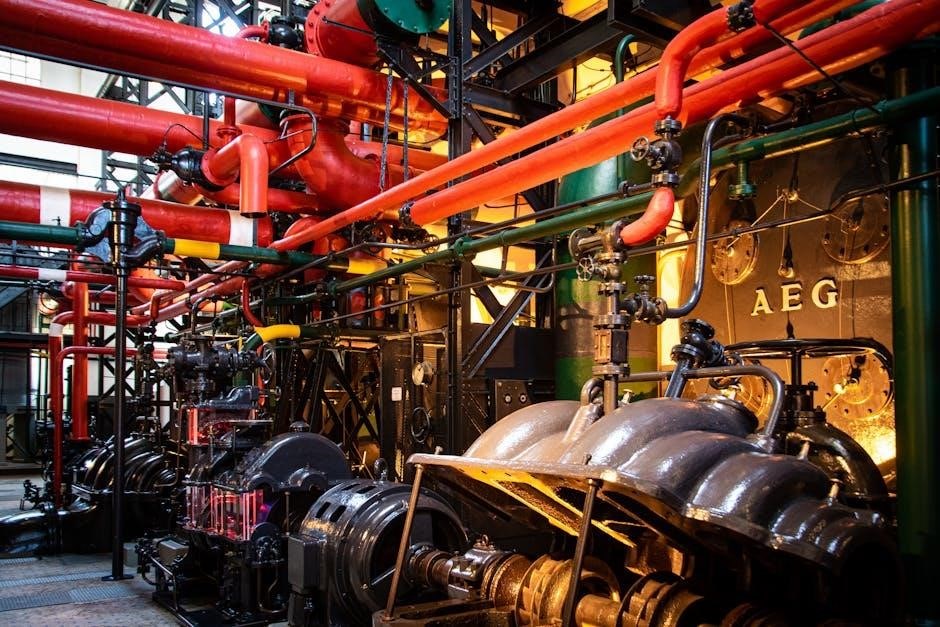
what is a valve guide
A valve guide is a critical component in internal combustion engines, serving as a cylindrical sleeve that directs the valve stem, ensuring proper movement and sealing within the valvetrain system. Made from durable materials like bronze or cast iron, it minimizes wear and tear, enhancing engine efficiency and performance over time.
1.1 Definition and Purpose
A valve guide is a cylindrical component in an engine’s valvetrain system, designed to direct the valve stem and ensure proper alignment within the engine head. Its primary purpose is to facilitate smooth, consistent movement of the valves, enabling precise opening and closing to regulate airflow and combustion processes. The valve guide minimizes lateral movement of the valve stem, ensuring proper sealing and efficient engine operation. By maintaining precise valve alignment, it prevents premature wear on engine components, thereby enhancing overall performance and longevity. This critical role makes the valve guide indispensable for reliable engine functionality and optimal power delivery.
1.2 Importance in Engine Performance
Valve guides play a pivotal role in maintaining optimal engine performance by ensuring precise valve operation. They prevent excessive valve stem movement, which could disrupt combustion timing and reduce power output. Properly functioning valve guides enhance engine efficiency by maintaining consistent airflow and fuel combustion. Additionally, they help minimize oil consumption by sealing the valve stem area, preventing oil from entering the combustion chamber. Over time, worn valve guides can lead to decreased performance, increased emissions, and potential engine damage. Their reliability directly impacts the engine’s overall power delivery, fuel efficiency, and operational longevity.
1.3 Brief History and Evolution
Valve guides have evolved alongside internal combustion engine technology. Early engines used simple, often rudimentary guides that were prone to wear. In the mid-20th century, materials like bronze and cast iron became standard, improving durability. Modern valve guides incorporate advanced machining techniques and specialized coatings to enhance performance and longevity. The development of high-performance engines drove innovations, such as oversized guides for racing applications. Today, valve guides are precision-engineered to minimize wear and optimize engine efficiency, reflecting a century of refinement in materials and design. This evolution ensures they remain a critical component in modern engines.

Function and Operation
Valve guides ensure proper valve movement and sealing within the valvetrain system, directing the valve stem and minimizing wear. Their durability enhances engine efficiency and performance.
2.1 Role in Engine Valvetrain System
Valve guides play a crucial role in the engine’s valvetrain system by supporting the valve stems and ensuring precise movement. They align the valves correctly with the valve seats, enabling proper sealing and efficient combustion. Made from durable materials like bronze or cast iron, valve guides withstand high temperatures and mechanical stress. Their smooth surface reduces friction, promoting consistent engine performance. Additionally, they help maintain proper valve train geometry, which is essential for optimal engine operation; By guiding the valves accurately, they contribute to better fuel efficiency, power output, and overall engine reliability.
2.2 How Valve Guides Contribute to Proper Valve Sealing
Valve guides ensure proper valve sealing by maintaining precise alignment between the valve stem and seat. This alignment prevents leaks and allows the valve to close securely, optimizing combustion efficiency. Guides made from materials like bronze or cast iron withstand high temperatures and wear, reducing the risk of misalignment. Proper sealing prevents oil consumption, reduces emissions, and maintains engine performance. If guides are worn, valves may not seal correctly, leading to reduced power and increased oil burn. Thus, valve guides are essential for maintaining the integrity of the valvetrain system and ensuring efficient engine operation over time.
2.3 Impact on Engine Efficiency and Power
Valve guides significantly influence engine efficiency and power by ensuring proper valve operation. They maintain precise valve alignment, enabling efficient airflow and combustion. Worn guides can lead to reduced compression, power loss, and increased oil consumption. Properly functioning guides minimize valve train wear, optimize fuel efficiency, and enhance overall engine performance. Misaligned or damaged guides can disrupt airflow, reducing horsepower and torque. Maintaining or replacing worn guides restores engine efficiency, ensuring maximum power output and minimizing emissions. Thus, valve guides play a crucial role in sustaining optimal engine performance and power delivery. Regular maintenance is essential to prevent performance degradation over time.

Design and Construction
Valve guides are precision-engineered components, typically made from durable materials like bronze or cast iron. Their cylindrical design ensures proper valve stem alignment, promoting smooth operation and longevity.
3.1 Materials Used for Valve Guides
Valve guides are typically constructed from durable materials such as bronze, cast iron, or steel alloys. Bronze is favored for its excellent wear resistance and heat dissipation properties, while cast iron offers cost-effectiveness and sufficient durability for most applications. In high-performance engines, advanced materials like phosphor bronze or ceramic-coated guides are used to enhance strength and reduce friction. The choice of material depends on the engine’s operating conditions, with prioritization of thermal stability, lubricity, and longevity. Proper material selection ensures optimal performance and minimizes wear over time.
3.2 Common Designs and Variations
Valve guides are available in various designs to suit different engine requirements. Integral guides are machined directly into the cylinder head, offering simplicity and durability. Replaceable guides, on the other hand, are pressed into the head and can be replaced without extensive machining. Some designs feature oversized diameters for repairing worn guides, while others incorporate coatings or surface treatments for enhanced wear resistance. Threaded guides allow for easier installation and adjustment. These variations cater to different engine types, from standard passenger vehicles to high-performance racing engines, ensuring optimal fitment and functionality.

3.3 Manufacturing Process and Quality Control
The manufacturing of valve guides involves precision machining to ensure tight tolerances and durability. High-quality materials like bronze or cast iron are typically used, with surface treatments applied for enhanced wear resistance. The process includes CNC machining for exact dimensions, followed by heat treatment to improve strength. Quality control measures involve rigorous inspections, including dimensional checks and surface finish analysis. Some manufacturers also conduct performance testing under simulated engine conditions to ensure reliability. Certifications and industry standards are adhered to, guaranteeing consistent quality and reliability in the final product.

Types of Valve Guides
Valve guides come in integral and replaceable types, with materials such as bronze and cast iron offering durability and thermal resistance, suited for various engine applications.
4.1 Integral vs. Replaceable Valve Guides
Integral valve guides are cast directly into the cylinder head, offering durability but requiring specialized machining if replacement is needed. Replaceable guides, on the other hand, are inserted into the head, making them easier to replace without extensive engine disassembly. Integral guides are typically more cost-effective for OEM applications, while replaceable guides provide flexibility for high-performance or repair scenarios. Both types are designed to ensure proper valve alignment and sealing, with materials like bronze or cast iron chosen for their heat resistance and wear characteristics. The choice between them depends on engine design, maintenance needs, and performance requirements.
4.2 Cast Iron vs. Bronze Valve Guides
Cast iron valve guides are durable and cost-effective, commonly used in standard engine applications due to their heat resistance and strength. Bronze valve guides, however, are preferred for high-performance engines as they offer superior wear resistance and thermal conductivity. Bronze guides minimize the risk of seizing and provide smoother valve operation, making them ideal for engines subjected to high stress. While cast iron is more affordable, bronze guides deliver enhanced performance and longevity, especially in demanding conditions. The choice between the two depends on the engine’s requirements, with bronze being the better option for durability and performance.
4.3 Specialized Valve Guides for High-Performance Engines
Specialized valve guides are designed for high-performance engines, offering enhanced durability and precision. These guides often feature advanced materials, such as high-strength bronze alloys or coated surfaces, to withstand extreme temperatures and friction. They are engineered to maintain tight tolerances, ensuring consistent valve operation under intense conditions. High-performance guides may also incorporate lubrication-enhancing designs to reduce wear and improve efficiency. These components are critical in racing and high-output engines, where reliability and peak performance are paramount. Their superior construction minimizes the risk of failure, making them a vital upgrade for engines pushed to their limits.

Wear and Tear
Valve guides experience wear due to insufficient lubrication, high temperatures, and improper installation. This leads to increased oil consumption and engine smoke, signaling worn guides.
5.1 Signs of Worn Valve Guides
Worn valve guides often exhibit noticeable symptoms, including excessive oil consumption, engine smoke upon startup, and increased valve clearance. Noisy valvetrain operation and decreased engine performance are also common indicators. Over time, worn guides can lead to improper valve sealing, reducing efficiency and power output. If left unaddressed, these issues can escalate, causing further damage to engine components. Regular inspections and maintenance are crucial to identifying wear early and preventing costly repairs. Understanding these signs helps in addressing the problem promptly, ensuring optimal engine functionality and longevity.
5.2 Causes of Premature Wear
Premature wear on valve guides is often due to insufficient lubrication, overheating, or improper installation. Lack of oil flow and excessive heat can degrade the guide material, leading to rapid deterioration. Additionally, loose valve guides or misaligned valve stems can cause uneven wear. High-mileage engines and aggressive driving conditions, such as frequent stop-and-go traffic or high RPM operations, also accelerate wear. Improper maintenance, like neglecting to clean or inspect guides, further exacerbates the issue. Addressing these factors early can help prevent premature wear and extend the lifespan of the valve guides and overall engine performance.
5.3 Consequences of Neglecting Valve Guide Maintenance
Neglecting valve guide maintenance can lead to severe engine damage and performance issues. Worn guides allow excessive oil consumption, emitting blue smoke from the exhaust and increasing emissions. This can damage catalytic converters and other components. Additionally, improper sealing causes reduced compression, leading to decreased power, rough idling, and poor fuel efficiency. Over time, neglected guides may cause valves to seize or break, requiring costly repairs. Regular maintenance is crucial to prevent these issues, ensuring optimal engine performance and longevity. Addressing valve guide wear early can save time and money, avoiding more extensive and expensive engine overhauls down the line.

Installation and Replacement
Valve guide installation requires precision to ensure proper fitment and alignment. Specialized tools are used to remove old guides and press in new ones, ensuring optimal engine performance;
6.1 Tools and Equipment Needed
Replacing valve guides requires specialized tools to ensure accuracy and avoid damage. Essential tools include a valve guide puller to remove worn guides and a hydraulic press or driver to install new ones. A valve stem seal installer is necessary for proper sealing. Additionally, a micrometer or dial bore gauge is used to measure guide clearance and ensure precise fitment. Specialized pilot bushings and alignment tools may also be needed, depending on the engine type. Using the correct tools is crucial to prevent damage to the engine head or valvetrain components during the replacement process.
6.2 Step-by-Step Replacement Process
Replacing valve guides involves several precise steps. First, remove the engine head to access the guides. Next, use a valve guide puller to extract the worn guide from the head. Clean the area thoroughly to ensure proper installation. Insert the new guide using a hydraulic press or driver, aligning it carefully. Reinstall the engine head and reconnect all components. Tighten bolts in the specified sequence to avoid warping the head. Finally, test the engine to ensure proper function and sealing. Each step requires attention to detail to maintain engine performance and prevent further damage.
6.3 Tips for Proper Installation
- Ensure the head is clean and free of debris before installing new guides.
- Use a hydraulic press or driver to seat the guide properly, avoiding misalignment.
- Apply a thin layer of lubricant to the guide and surrounding area for smooth installation.
- Align the guide with the valve seat to maintain proper engine performance.
- Use a torque wrench to tighten bolts in the correct sequence to prevent head warping.
- Inspect the guide for any damage before installation to ensure longevity.

Maintenance and Repair
Regular cleaning and lubrication of valve guides prevent wear and tear. Inspecting for damage and replacing worn guides ensures optimal engine performance and longevity.
7.1 Cleaning and Lubrication
Cleaning and lubricating valve guides are essential for maintaining proper engine function. Use solvents and brushes to remove dirt and oil residue, ensuring smooth operation. Apply engine oil or specialized greases to reduce friction and prevent wear. Regular lubrication helps maintain the integrity of the valve guide and stem, ensuring proper sealing and movement. Avoid using abrasive materials that could damage the surface. Proper cleaning and lubrication are crucial for extending the lifespan of valve guides and preventing premature wear. Neglecting this step can lead to increased engine noise and reduced performance over time.
7.2 Repair vs. Replacement: When to Choose Which
Deciding between repairing and replacing valve guides depends on the extent of wear; Minor damage, such as light scoring, can often be repaired through machining or resurfacing. However, if the guides are severely worn, cracked, or excessively loose, replacement is typically necessary. Repair is cost-effective for minor issues, while replacement ensures long-term reliability. Consider the age and condition of the engine when making this decision. If the engine is high-mileage, replacement may be more practical. Always assess the guides thoroughly and consult a professional for severe cases to avoid further engine damage.
7.3 Preventative Measures to Extend Lifespan
Regular maintenance is key to extending the life of valve guides. Ensure proper lubrication by using high-quality oils, as insufficient lubrication can lead to premature wear. Periodically inspect the guides for signs of wear, such as scoring or excessive clearance. Addressing these issues early prevents further damage. Keeping the engine clean and free from debris also reduces stress on the guides. Additionally, avoiding excessive engine heat and maintaining proper valve clearance can significantly prolong their lifespan. Regular servicing and prompt repairs are essential to prevent minor issues from escalating into costly problems. Consistent care ensures optimal performance and durability.

Common Issues and Solutions
Common issues include excessive oil consumption, worn seals, and guide wear. Solutions involve replacing seals, resurfacing guides, and ensuring proper lubrication to maintain engine performance and efficiency.
8.1 Oil Consumption and Valve Guide Seals
Excessive oil consumption is often linked to worn valve guide seals, which allow engine oil to enter the combustion chamber. This can result in blue smoke from the exhaust and increased oil use. Over time, worn guides and seals can lead to valve stem wear, further exacerbating the issue. Proper diagnosis involves inspecting the valve guide seals and measuring guide clearance. Replacing worn seals and resurfacing or replacing damaged guides can resolve the problem. Regular maintenance, such as checking valve guide condition during routine services, helps prevent excessive oil consumption and maintains engine efficiency and performance.
8.2 Addressing Valve Guide Wear in High-Mileage Engines
Valve guide wear in high-mileage engines is common due to prolonged use and heat exposure. Symptoms include oil leakage, increased emissions, and reduced performance. Inspection involves measuring guide clearance and checking for wear patterns. Cleaning the guides and replacing worn seals can often resolve minor issues. In severe cases, resizing or replacing the valve guides is necessary to restore proper valve alignment and sealing. Refacing the valve seats may also be required for optimal performance. Regular maintenance, such as lubrication and inspection, can help prevent premature wear and extend the lifespan of the valvetrain components in older engines.
8.3 Diagnosing and Fixing Leaks
Diagnosing leaks related to valve guides often involves identifying excessive oil consumption or smoke during engine operation. Common causes include worn valve guide seals or damaged guide surfaces. A compression test can reveal leaks, while a visual inspection may show oil residue near the guides. To fix leaks, replace worn seals or guides, ensuring proper alignment and seating. In some cases, machining or replacing the entire guide may be necessary. Proper lubrication and torque specifications during repair are crucial to prevent future issues and restore engine performance. Regular inspections can help catch leaks early, avoiding costly damage.

Advanced Topics
Advanced topics explore valve guide machining, performance upgrades, and case studies, offering insights into precision engineering and high-performance applications for optimal engine efficiency and durability.
9.1 Valve Guide Machining and Refacing
Valve guide machining and refacing involve precision engineering to restore or modify guides, ensuring proper valve stem alignment and sealing. This process often includes resurfacing worn areas to maintain optimal dimensions and surface finish. Specialized tools and techniques are used to achieve precise tolerances, critical for engine performance. Refacing may involve installing oversized or coated sleeves for durability, especially in high-performance engines. Proper machining ensures minimal wear on moving parts, enhancing engine efficiency and longevity. This advanced procedure is typically performed by skilled technicians using high-quality materials like bronze or cast iron, tailored to specific engine requirements and operating conditions.
9.2 Upgrading to Performance Valve Guides
Upgrading to performance valve guides enhances engine efficiency and durability, particularly in race or high-performance engines. These guides are crafted from premium materials like coated or hardened steel, offering improved heat resistance and reduced wear. Designed with tighter clearances, they ensure precise valve stem alignment, minimizing oil consumption and maximizing power output. Performance guides often feature advanced geometries and surface finishes, optimizing lubrication and reducing friction. This upgrade is crucial for engines operating under extreme conditions, ensuring reliable performance and longevity. By addressing wear and thermal stress, performance valve guides contribute to sustained engine health and peak performance capabilities in demanding environments.
9.3 Case Studies of Successful Repairs
Several case studies highlight the importance of proper valve guide repairs. For instance, a 4jj1 engine experienced excessive oil consumption due to worn guides. After replacing them with performance guides, oil use returned to normal. Another case involved a high-mileage DS1000 engine with noisy valvetrain. Upgrading to hardened steel guides resolved the issue. Additionally, a Mini Cooper S Turbo underwent successful valve seal and guide replacement, eliminating startup smoke. These examples demonstrate how addressing valve guide wear can restore engine performance and prevent further damage, emphasizing the value of timely repairs and upgrades in maintaining engine health and efficiency over time.
Valve guides are essential for engine efficiency, ensuring proper valve operation and sealing. Made from durable materials, they prevent oil leakage and maintain performance. Regular maintenance is crucial to extend their lifespan and avoid costly repairs, ensuring optimal engine function and longevity.
10.1 Summary of Key Points
A valve guide is a cylindrical sleeve that directs the valve stem, ensuring proper movement and sealing within the engine’s valvetrain system. It plays a crucial role in maintaining engine efficiency by preventing oil leakage and wear. Made from durable materials like bronze or cast iron, valve guides are designed to withstand high temperatures and mechanical stress. Regular maintenance is essential to prevent issues such as excessive oil consumption or performance loss. Over time, worn guides can lead to engine damage, emphasizing the importance of timely inspection and replacement. Proper care ensures optimal engine function and longevity.
10.2 Final Thoughts on Valve Guide Importance
Valve guides are a cornerstone of engine reliability, ensuring proper valve operation and preventing oil leakage. Neglecting their maintenance can lead to increased oil consumption, reduced performance, and potential engine damage. Regular inspection and timely replacement are crucial to uphold efficiency and longevity. While often overlooked, valve guides play a vital role in maintaining optimal engine function, making them indispensable for both everyday driving and high-performance applications. Proactive care ensures smooth operation and avoids costly repairs down the line.
10.3 Encouragement for Proper Maintenance
Proper maintenance of valve guides is essential to ensure long-term engine health and performance. Regular inspections can prevent premature wear, oil leaks, and potential engine damage. Cleaning and lubricating valve guides helps maintain smooth operation, while addressing issues early avoids costly repairs. By prioritizing maintenance, you extend the lifespan of your engine and enhance its efficiency. Stay proactive to keep your engine running smoothly and reliably for years to come. Consistent care not only saves money but also ensures optimal performance, making it a worthwhile investment in your vehicle’s longevity and functionality.